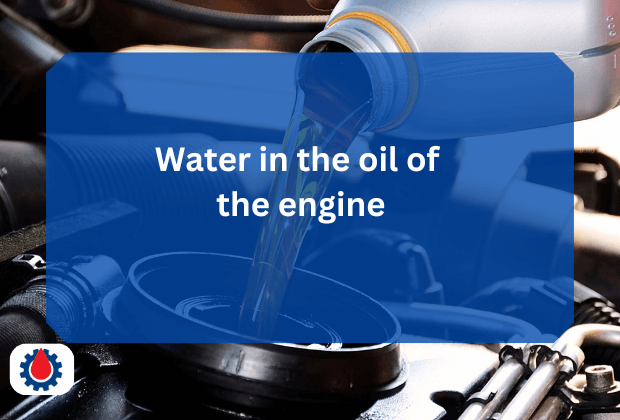Water in engine oil is a serious issue that can compromise the performance and longevity of a vehicle’s engine. While engines are designed to handle intense heat, pressure, and mechanical stress, the presence of water in the oil can lead to a cascade of problems, from reduced lubrication to catastrophic engine failure.
In this post, we’ll explore the causes of water contamination in engine oil, its effects on engine performance, and practical solutions to address and prevent this issue.
Water in the Oil of the Engine
Water can infiltrate engine oil through several pathways, some of which are natural byproducts of engine operation, while others indicate underlying mechanical issues. Here are the primary causes:
1. Condensation
Engines operate in environments where temperature fluctuations are common. When an engine cools down after running, moisture from the air can condense inside the crankcase, especially in colder climates or during short trips where the engine doesn’t reach optimal operating temperature. This condensation can mix with the oil, creating a milky or frothy appearance.
2. Coolant Leaks
A more severe cause of water in engine oil is a coolant leak. Engine coolant, which is typically a mixture of water and antifreeze, can leak into the oil system due to a damaged head gasket, cracked cylinder head, or faulty engine seals. This is one of the most concerning causes, as it often signals a major mechanical issue.
3. Flooding or Submersion
Vehicles exposed to heavy flooding or driven through deep water may ingest water into the engine. If water enters the combustion chamber or crankcase, it can mix with the oil, leading to contamination.
4. Improper Maintenance
Neglecting regular oil changes or using low-quality oil can exacerbate water accumulation. Over time, oil can become saturated with contaminants, including water, reducing its effectiveness and allowing moisture to build up.
Related Additive To Remove Water From Engine Oil(Top 5 Best 2025)
How to Identify Water in Engine Oil
Detecting water contamination early can save you from costly repairs. Here are some telltale signs:
- Milky or Creamy Oil: When water mixes with oil, it forms an emulsion that looks like a light brown or milky substance on the dipstick or oil filler cap.
- Overheating: Water reduces the oil’s ability to lubricate, causing increased friction and heat in the engine.
- White Smoke from Exhaust: This can indicate coolant leaking into the combustion chamber, which may also contaminate the oil.
- Low Oil Pressure: Contaminated oil may not flow properly, leading to low oil pressure warnings.
- Engine Misfires or Rough Running: Water in the oil can affect engine performance, leading to misfires or sluggish operation.
If you notice any of these symptoms, it’s critical to investigate further or consult a professional mechanic.
Related Engine Overheating After Oil Change(6 Causes + Solutions)
The Effects of Water in Engine Oil
Water in engine oil can have devastating consequences if left unaddressed. Here’s how it impacts your engine:
1. Reduced Lubrication
Oil’s primary function is to lubricate moving parts, reducing friction and wear. Water dilutes the oil, lowering its viscosity and compromising its ability to form a protective film. This leads to increased wear on components like bearings, pistons, and camshafts.
2. Corrosion and Rust
Water is corrosive, especially when mixed with the acids and contaminants already present in engine oil. Over time, this can cause rust and corrosion on metal surfaces, leading to pitting and premature component failure.
Related How to Fix Milky Oil in Engine(In 7 Easy Steps)
3. Sludge Formation
When water emulsifies with oil, it can create sludge—a thick, gooey substance that clogs oil passages and restricts flow. This reduces the engine’s efficiency and can lead to overheating or component failure.
4. Engine Damage
In severe cases, water in the oil can cause catastrophic engine damage. For example, a blown head gasket may allow coolant to flood the oil system, leading to hydrolock (when water prevents the piston from moving) or bearing failure.
Related White Stains Engine Splatter After Oil Change(4 Causes + Solutions)
Solutions to Address Water in Engine Oil
If you suspect water contamination, prompt action is essential. Here are the steps to address and prevent the issue:
1. Diagnose the Problem
Start by checking the dipstick and oil filler cap for signs of water contamination. If the oil appears milky, perform a thorough inspection or take the vehicle to a mechanic. Diagnostic tools like a compression test or a coolant system pressure test can help identify issues like a blown head gasket.
2. Change the Oil
If the contamination is minor (e.g., due to condensation), changing the oil and filter can resolve the issue. Use high-quality oil recommended by the vehicle manufacturer and ensure regular oil changes to prevent future buildup.
Related Engine Tick After Oil Change(5 Causes + Solutions)
3. Repair Mechanical Issues
For more severe cases, such as coolant leaks, address the root cause of the issue. Common repairs include:
- Replacing a Head Gasket: A blown head gasket requires professional repair, as it involves disassembling parts of the engine.
- Fixing Cracked Components: A cracked cylinder head or engine block may need replacement or professional welding.
- Sealing Leaks: Faulty seals or gaskets should be replaced to prevent further coolant intrusion.
4. Prevent Condensation
To minimize condensation, ensure the engine reaches its optimal operating temperature during drives. Short trips prevent the engine from burning off moisture, so consider taking longer drives periodically or installing an engine block heater in cold climates.
5. Regular Maintenance
Adhere to a regular maintenance schedule, including oil changes, coolant checks, and inspections of the cooling system. Using high-quality oil and coolant can reduce the risk of contamination.
Related Oil Change Interval Calculator
6. Avoid Flooded Areas
If you live in an area prone to flooding, avoid driving through deep water. If your vehicle has been submerged, have it inspected immediately to prevent water from damaging the engine.
Preventing Water Contamination in the Future
Prevention is always better than repair. Here are some tips to keep water out of your engine oil:
- Monitor Coolant Levels: Low coolant levels may indicate a leak that could contaminate the oil.
- Use Quality Fluids: Always use manufacturer-recommended oil and coolant to ensure compatibility and performance.
- Regular Inspections: Have your vehicle inspected regularly by a qualified mechanic to catch issues early.
- Drive Smart: Avoid short trips in cold weather and ensure your engine warms up properly to reduce condensation.
Final words
Water in engine oil is a problem that ranges from a minor annoyance to major mechanical failure, depending on the cause and severity. By understanding the causes, such as condensation, coolant leaks, or flooding, and recognizing the symptoms, you can take swift action to protect your engine.
If you suspect water in your engine oil, don’t delay, address the issue promptly to avoid costly repairs and keep your engine in top shape.




